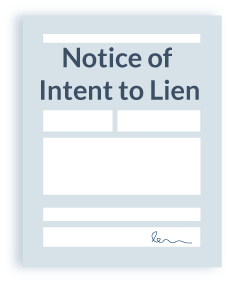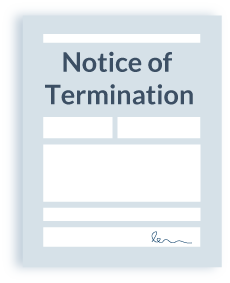
During the course of a construction project, there are many moments when a “notice” will be required, sent, filed, received, or requested. Sometimes required by law, other times by contract, these notices may range from being administrative, voluntary, or extremely required.
Construction notices can be very confusing because there are so many different types, as different notices are required for different occasions. Further complicating matters is the language, because people call them by different names. For example, it’s very common for the same type of notice to be called different things in different regions, such as the “preliminary notice” in California being the same thing as the “notice to owner” in Florida.

This guide will provide an introduction to all of the notices you may encounter on a construction job. After reading this guide and frequently asked questions, you should be free of all confusion about notices in construction, you’ll know which notices serve which purposes, and you’ll always be able to figure out what notice is needed for any given situation.
Notices That Must Be Filed To Indicate Progress on the Project
We’ll start with construction notices that are filed publicly to broadcast when a construction project has begun, and when it has concluded.
As you’ll see in the below discussion, the “Notice of Commencement” (i.e. filed at the start of the project) and the “Notice of Completion” (i.e. filed at the end of a project) are commonly required on projects in the United States, but are not always required.
Whether these documents are required or customary filings will depend on where your project is located.
Notice of Commencement

There are a few states that require property owners or general contractors to file a “Notice of Commencement” at the start of a construction project. As you can see in this map of the NOC requirements across the country, the 5 states that require a NOC are Florida, Georgia, Ohio, Michigan, and Iowa. The NOC is mentioned by law and optional in Texas, South Carolina, and South Dakota. Other than in these 8 states, the “notice of commencement” document, process, and concept does not exist.
Generally, the Notice of Commencement is filed with the county recorder’s office at the start of a construction project. This document marks the formal beginning date for the project, it publishes key information about the project to interested stakeholders (such as subcontractor and suppliers), and helps property developers, construction lenders, and general contractors manage and mitigate their exposure to mechanics lien filings on the job.
A Notice of Commencement can really be helpful to subcontractors and suppliers who want to make payment faster and smoother. Since payments ultimately get issued by property owners, construction lenders, and general contractors, it’s critical that subs & suppliers make it easy for these parties to pay them and get money to them. The first step for this is making certain that these parties know one another. And as we’ve explored in previous articles, it can be more complicated than you’d think to just figure out who the stakeholders are on a project.
NOCs can also be really helpful for property developers, general contractors, and construction lenders who are interested in mitigating the financial risks of mechanic lien filings. In most states, these parties must have intricate processes for tracking and handling lien waivers to trace payments made to all of the subs and suppliers on the job. This definitely is a best practice to avoid surprise lien claims.
Notices of Commencement filings can help this as well, as these filings typically:
- Require that subs & suppliers must send preliminary notice to protect their lien rights, which makes lien waiver tracking easier
- Create short lien deadlines and lien periods, which makes the window of risk for the project coordinators shorter and easier to handle
Be careful — There are deadlines associated with filing a notice of commencement! In some states, NOCs only need to be filed on projects of certain sizes, such as in Florida, where the NOC needs to be filed only on jobs above $2,500 in value. And finally, the NOC must contain all of the required information, which in some states may include an estimate of the job’s value (which may be sensitive information to publish)!
Notice of Completion

The Notice of Completion is a document filed at the conclusion of a construction project; it is a complement to the Notice of Commencement, which is filed at the start of a project. Just like the Notice of Commencement, the Notice of Completion is a document filed with the county, is typically filed by the general contractor or property developer, and has implications for the mechanic’s lien time periods and rights of contractors and suppliers on the job.
The Notice of Completion (which also goes by names like the Notice of Cessation) marks the “completion” of a job. Because of concepts like final completion and substantial completion, it can be confusing or debatable about when the project actually ends. This has implications to a contractor or suppliers’ lien rights, and the exposure window for other stakeholders.
Having a document recorded indicating the completion of the job can be extremely helpful for all parties involved with a job, however, you’ll typically only find these documents in the states that have an explicit process for them (which is generally the same states that have notice of commencement rules).
Notices That Are Exchanged Related to Lien & Bond Claim Rights
The above section gave an overview of two construction notice documents that are filed with county recorder offices to indicate the progress of a construction job. These two above discussed notices — the “Notices of Commencement” and “Notice of Completion” — do impact mechanics lien and bond claim rights. They can, for example, shorten or lengthen the time that contractors and suppliers have to file a lien; or, they can determine whether a preliminary notice is or is not required. Nevertheless, they are discussed outside of this section, as this section addresses notices that are more directly tied to the mechanic’s lien and bond claims right process.
The construction notices discussed in this section are notices exchanged between parties on a job that relates to the project’s lien rights. Whether these notices are or are not required, when they must be sent, how they must be sent, who they must be sent to, etc., etc., are all questions without an individual answer. The construction notices requirements depend significantly on where your project is located, and what type of project you’re on.
Preliminary Notices
Here at Levelset, we have written extensively about preliminary notices, and have substantial preliminary notice resources available. These “construction notices” are probably the most popular and referenced type of notice whenever someone says “construction notice,” but that can be confusing because of all the other notices exchanged on a project (see this entire article!), and the fact that these “preliminary notices” go by tons of other names. Depending on where you are and the parlance of that state or region, these notices are also called a twenty-day notice, construction notice, pre-lien notice, prelim, notice to owner, NTO, notice to contractor, and notice of furnishing, or even, inappropriately, a lien notice.

Send a notice with Levelset
It only takes a few minutes to send a notice on any job.
Generally speaking, preliminary notices are sent by contractors or suppliers at the start of a construction project. These notices must typically be sent within a certain number of days from when a project begins, and must be sent by to the property owner and general contractor. When a preliminary notice is required, not sending the notice could result in fines and penalties (see example in Nevada and California), but will almost certainly result in the party losing their lien rights.
On the one hand, preliminary notices are important because it’s required that they be sent them on certain jobs. However, these documents are also important because they help contractors and owners administer payment on the job, and in fact, owners and general contractors will prioritize invoices from contractors and suppliers who have sent notices! You want to be one of those.

Discover how a Florida contractor’s average DSO went from 60 days to 14 days after sending notices on every job.
Notice of Intent to Lien

The “Notice of Intent To Lien” is sent by contractors or suppliers who are unpaid for their work and/or materials. It is commonly confused with a lot of other different types of construction & lien notices. You should send a notice of intent to lien soon before filing a lien — typically, 10 days. These are required only in some states, but it’s a good idea to send one of these if you have time. These documents are warnings to other people on the job that you will file a lien if not paid immediately for an invoice or overdue pay application. See how the notice of intent can help you get paid with this webinar: NOIs — The Secret Weapon to Getting Paid.
It is not a preliminary notice: Unlike the preliminary notice, which is sent at the start of a job before any payment is due and is an informational notice, the notice of intent to lien is sent only when an account is unpaid and past due.
This is a warning letter sent to a property developer, owner, or general contractor, notifying them that you will soon file a mechanics lien if payment is not made immediately. The notice of intent and preliminary notice documents are often confused, and it’s an important confusion to avoid!
It is not a mechanics lien or notice of mechanics lien: Many states actually require that a “notice of a mechanics lien filing” is delivered to property owners or general contractors at the time that a lien is filed. These are sometimes called “notices of lien.” Further, people will oftentimes get confused about these documents and think that they are actually filing their mechanics lien by sending a notice of intent to lien. Neither of these are correct. The notice of intent to lien is a separate document sent by a contractor or supplier immediately before filing a lien which warns other parties on the job that a lien will be filed if they are not immediately paid. To help with this check out our article about the differences between a mechanics lien and a notice of intent to lien.
Fund-Trapping Notices

Another common construction notice is a “monthly notice” or “funds trapping notice.” These are also called “pre-lien notices,” “recurring notices,” or may go by the name of their location, such as “Texas notices” or “Texas monthly notices.“
These are a hybrid notice, something in-between a preliminary notice and a notice of intent to lien. They are only required (and only exist) in three states — Texas, Tennessee, and Louisiana.
They can be extremely confusing, and because of their complexity, they present difficulties in creating policies and procedures to send them.
Monthly notices are a hybrid notice because they are not exactly a preliminary notice (i.e. they aren’t sent at the beginning of the job), and they are not exactly a notice of intent to lien (i.e. they are not sent only before filing a lien). Instead, contractors and suppliers send monthly notices every month to notify other parties on their jobs about invoices or pay applications that are not paid after some period of time. So, for example, in Texas, a contractor or supplier might send a notice in May for all March invoices that have not yet been paid.
These operate like preliminary notices because it is required that they be sent to preserve lien rights. And they operate like notices of intent to lien because they are sent after some payment is already due and owing. But, as you can see, they don’t really work like either one.
They can also be called “fund-trapping notices,” “recurring notices,” or “pre-lien notices.” In some instances, like in Texas, the notices are referred to by when they are required to be sent, such as the “Second Month Notice” and the “Third Month Notice.”
Summary: Which Construction Notice Do You Need?
If you’re working on or supplying to a construction project in the United States, and you want to preserve your lien rights (and avoid fines & penalties!), then you’ll likely encounter some type of construction notice. These notices go by many different names. The three general categories of lien rights notices are preliminary notices, notices of intent to lien, and monthly notices. But figuring out which ones you should or must send, in which circumstance, can be tricky.
We recently conducted a free webinar that might help, called Which Notice Do I Need?
Notices Required & Exchanged Within Construction Contracts
The first two sections of this article reviewed construction notices that are required and pretty strictly regulated by laws, and mostly, laws that address mechanics lien and bond claim rights. In this final section, we’ll review a separate class of “construction notices.” We’ll review the notices that are commonly required and mentioned within a party’s construction contract.
In many cases, these notices help parties administer the work of the project, and furthermore, they help parties assert their claims and manage their risks and rights on a project. Since many construction contracts are long and complicated, it can be difficult to figure out which notices are required and when under the terms of a contract.
However, there are severe consequences to not exchanging the construction notices that are contractually required.
Notice to Proceed

A Notice to Proceed is a letter sent by one party (usually a general contractor) to another (usually a subcontractor) that urges the party to begin work.
Construction schedules are so susceptible to delay, and delay is expensive. Frequently, construction contracts will contain “liquidated damages” provisions for delays caused on a project. Too frequently, when parties start squabbling about job delays, each party will point fingers at the other and argue about when they could have begun work.
Sending a Notice to Proceed is helpful in these situations because it creates a more certain date when a party should have begun work on the job. A Notice to Proceed provides a clean, crystal-clear indication of when a particular party’s project work begins. That party’s performance time starts ticking from the date indicated in the Notice to Proceed document.
Request for Information Notice

It takes a lot of information to complete a job and to get it all done right. It takes a lot of information to administer a job. The Request for Information process — or RFI Process — is a type of construction notice that is allowed both under contract and law.
This process empowers one party to send a request to another party for more information.
This information may be required to get the job completed successfully (i.e. the subcontractor may need more information about the specifications for the work), or it may be required to bill the job successfully or protect lien rights (i.e. the subcontractor may need to know who the lender is and their billing requirements).
Learn more: RFI vs. RFP — What’s the difference?
Change Directive (Change Order Notice)
Another type of notice in construction relates to change orders, and is called a Construction Change Directive, or CCD. These notices can force contractors to create changes to their work, without their consent!
There are times during a construction project when a change needs to happen on the job, but the parties may not agree with one another enough about the scope, costs, or requirements of the change. Within a construction contract, the contractor may have the right to issue a “change directive,” which is a notice to the performing contractor to change some element of the project.
Learn more: Three ways the architect can change the work
Claim Notices

There is a little legal clause that’s part of many construction contracts called a “Claim Notice” provision, and it can be a really big headache for contractors.
This clause requires that, within some period of time from when the contractor learns about anything that might turn into a claim, the contractor must deliver a written “notice” of it.
These so-called “claim notices” must be sent within really short periods of time, sometimes even as short as 14 days! And if the claim notice is not sent, the claim can be null and void (some courts and arbitrators have been very strict about this).
The attorneys at Greensfelder have a nice write up on this on their “Nuts & Bolts” Construction Law Blog here: “The importance of timely and proper notice of a claim under a contract.”
Stop Work Notice

A stop work notice informs a property owner, general contractor, or other interested parties that, if payments are not made, work will be stopped within a period of time after the notice is given.
As outlined in this question on our Expert Center, it is often confused with the Stop Payment Notification. In almost every state, a contractor has the right to “stop work” if they are unpaid for their work or materials on a job.
Notice of Termination

Sometimes, for a variety of reasons, a property owner or general contractor will want to terminate a contractor from the job.
There are many instances when they have the legal right to terminate a contractor, but ultimately, to proceed, the party will need to deliver a “notice of termination.”
The process for doing this is usually provided for within the construction contract.
The attorneys at Squire Patton Boggs have a nice flyer on this, “Termination of Construction Contracts.”
Retention Notice

In construction, a certain amount of every payment is typically held back from a contractor throughout the course of a project. This is called “retention” or “retainage.”
In many cases, there is a formal process enumerated by the law for contractors to get their retainage money released to them, and this requires sending a “notice” to get retention released.
Another type of retainage notice acts like a preliminary notice, whereby parties must send a “retainage notice” at the start of a project to preserve their rights to file a lien on the project for retainage if later unpaid. In Texas, for example, this is known as a Notice of Contractual Retainage.
Frequently Asked Questions about Construction Notices
Q: Are notice requirements based on the state of the project, or the state where my company is located?
A: When it comes to legally required notices (i.e. filed notices and lien rights notices), the requirements are based on where the project is located. The state of your company or any other company on the project is irrelevant.
However, this question is more complicated for notices that are required and exchanged within construction contracts. In large part, those notices are governed by the terms of your construction contract. However, there are still rules!
As we explored in “The Battle Between Policy & Contract,” state laws regulate how much leverage a developer, lender, or contractor can use against one another. Accordingly, just become something is in your construction contract doesn’t mean it can’t be invalidated!
When it comes to whether a contract provision is or is not invalid, which state’s policy should apply? The state where the job is located, where the company is located, or even, where the contract says the terms should be interpreted (i.e. “this contract should be governed by the laws in the state of such and such…“)?
This is a complex question. The answer is likely the state where the project is located. But, if you’re dealing with such a detailed question, you could be in for a substantial (and expensive) legal fight!

Send a notice with Levelset
It only takes a few minutes to send a notice on any job.
